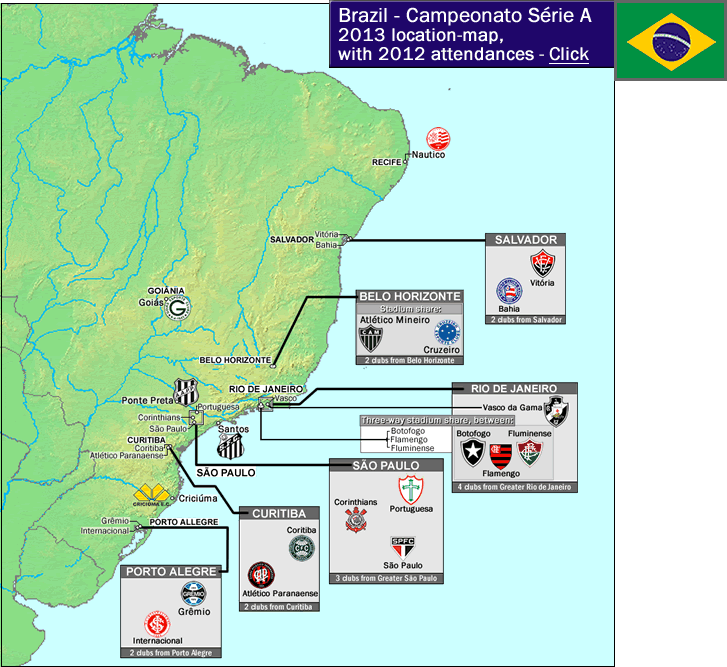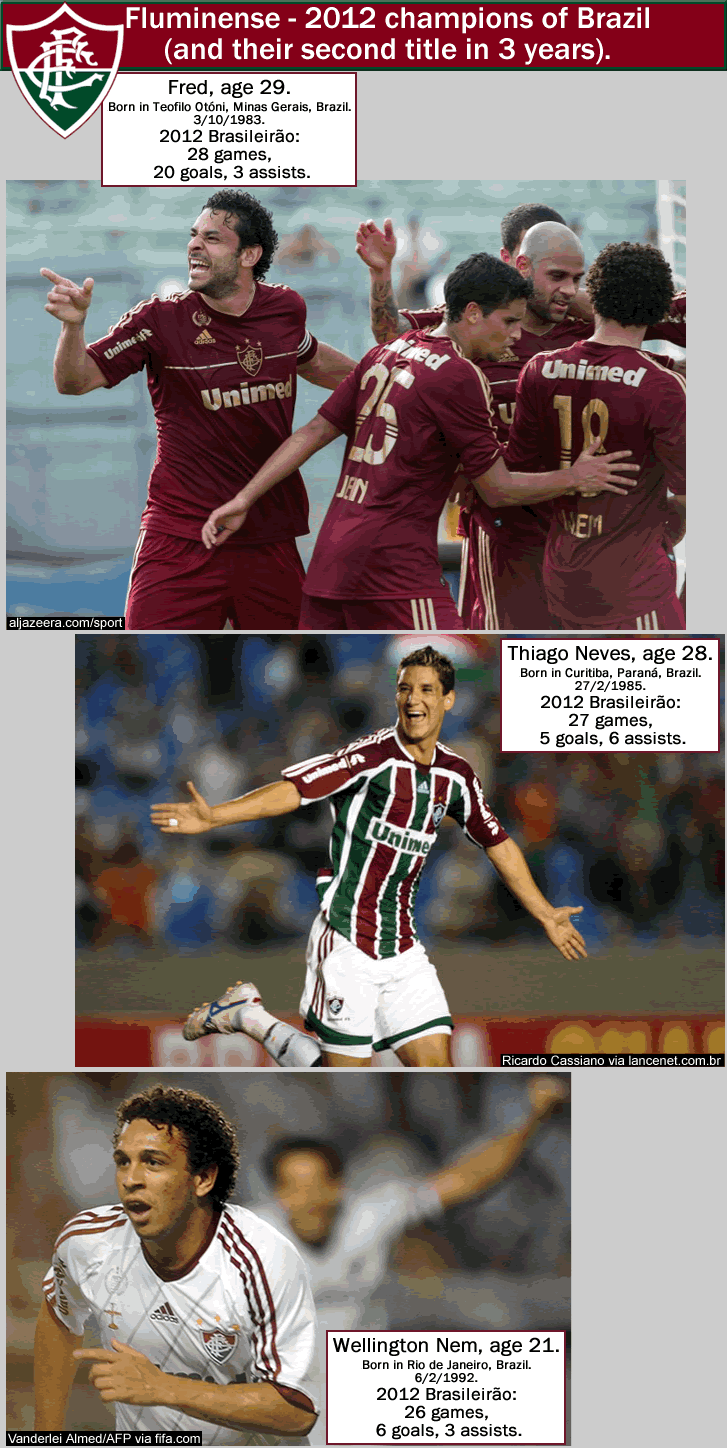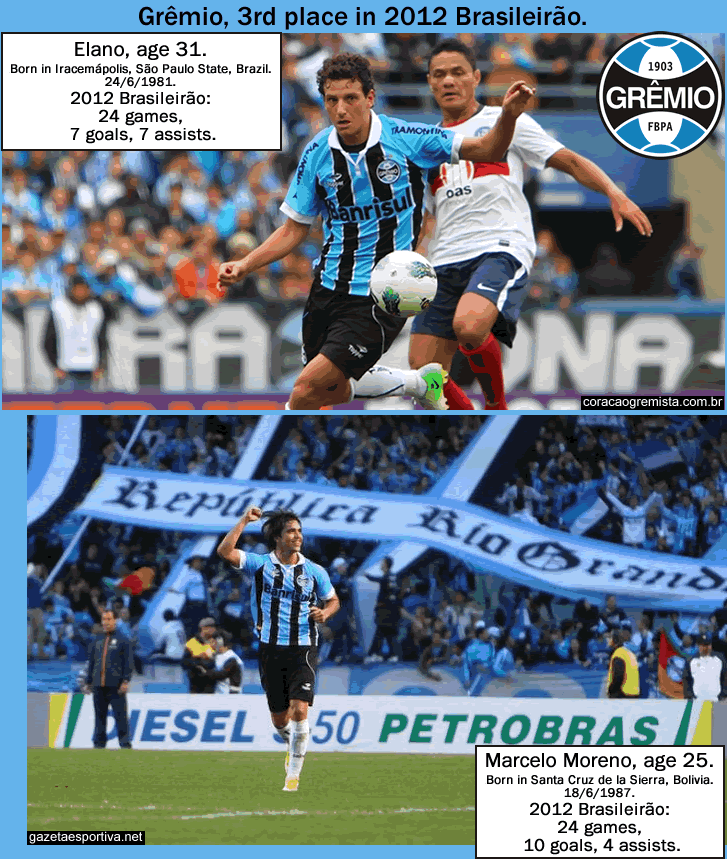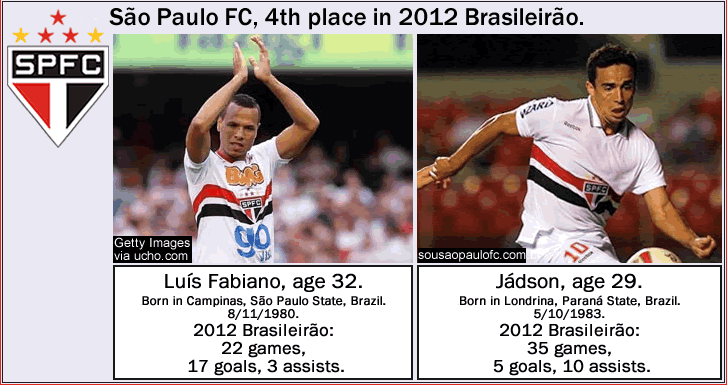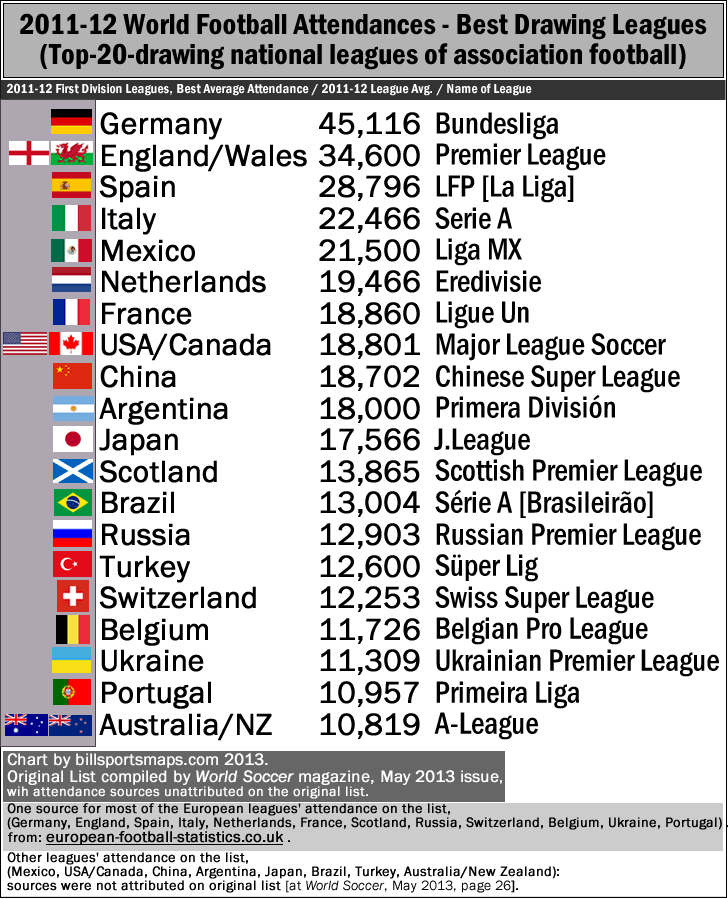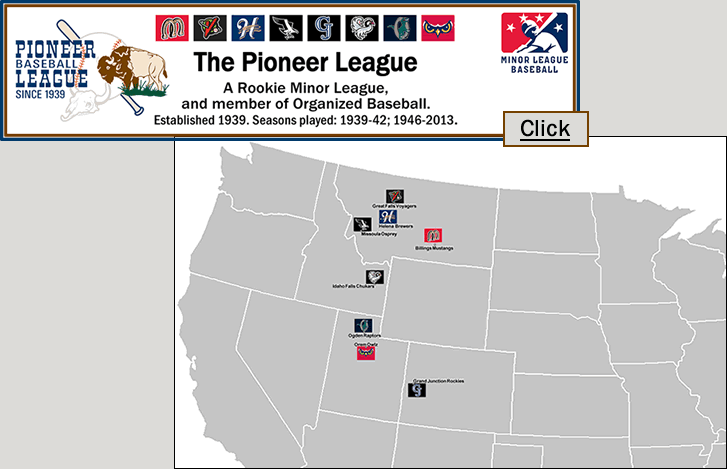
Minor League Baseball: the Pioneer Baseball League (Rookie Classification)
…
…
Pioneer League [official site].
Minor League Baseball attendance – ‘2012 Affiliated Attendance by League‘ (ballparkdigest.com).
There are 6 leagues within Organized Baseball which are Rookie classification leagues – the Appalachian League, the Pioneer League, the Arizona League, the Gulf Coast League, and 2 foreign-based leagues – the Dominican Summer League, and the Venezuelan Summer League. But in only two of these leagues are attendances measured. Those 2 are classified as Advanced-Rookie. They are the Appalachian League and the Pioneer League.
The Advance-Rookie classification
From the en.wikipedia page ‘Minor League Baseball’,…{excerpt}…”Leagues in the Rookie classification play a shortened season…starting in mid-June and ending in late August or early September. … Advanced Rookie leagues (Appalachian and Pioneer) play between 67 and 75 games… .
The Appalachian and Pioneer leagues are actually hybrid leagues; while officially classed as “Rookie” leagues, eight major league teams have their highest-class short season teams in those leagues. These eight teams also maintain Rookie-level teams in other leagues as well. The Gulf Coast and Arizona leagues are informally known as “complex” leagues, nicknamed for the minor-league complexes where most games in those leagues are played. …”{end of excerpt}.
{Excerpt from the ‘Pioneeer League‘ page at en.wikipedia.org} …”Classified as a Rookie league, the Pioneer League is predominantly made up of players out of high school and is almost exclusively the first professional league many players compete in.”…{end of excerpt}.
…
The teams in the Pioneer League are situated on either side of the Continental Divide in the foothills of the Rocky Mountains, with 4 teams in western and central Montana, one team in eastern Idaho, 2 teams in north-central Utah, and one team in western Colorado.
…
-
Below, a short history of the Pioneer League, with all present-day team locations noted...
The Pioneer League was established as a C-level minor league in 1939, and initially had teams in it from the states of Idaho and Utah and was a 6-team set-up that featured 4 Independent ball clubs. The teams in the first season of the Pioneer League in 1939 were – the Boise Pilots (Independent), the Lewiston (Idaho) Indians (Independent), the Ogden Reds (a Cincinnati Reds’ farm team), the Pocatello Cardinals (a St. Louis Cardinals’ farm team), the Salt Lake City Bees (Independent), and the Twin Falls Cowboys (Independent). One of those cities – Ogden, Utah – has a team in the present-day Pioneer League [the Ogden Raptors]. In the Pioneer League’s second season, in 1940, a New York Yankees’ farm team joined the Pioneer League – the Idaho Falls Russets. The present-day Pioneer League has a team in Idaho Falls [the Idaho Falls Chukars]. In the seventh season of the Pioneer League in 1948, the league expanded from 6 teams to 8 teams with the inclusion of 2 teams from Montana – the Billings Mustangs and the Great Falls Electrics. Both those teams were Independents. The present-day Pioneer League has teams from Billings and Great Falls [the Billings Mustangs {who have maintained the same name their entire existence}, and the Great Falls Voyagers {who are nicknamed after a UFO incident that took place at the empty Great Falls' ballpark in 1951 and was witnessed and filmed by the team's general manager, see this, second paragraph 'Great Falls Voyagers' (en.wikipedia.org); see this, 'Nick Mariana UFO Footage - 1950 - Great Falls, Montana' (youtube.com).}.
The Pioneer League existed from 1939 to 1962 as a Class C minor league (with the 1943 through 1945 seasons not played, due to to manpower shortages because of World War II) , then the circuit spent one season as a Class A minor league in 1963, then, in 1964 (as a 4-team league), it was placed several rungs further down the minor-league-ladder, when Major League Baseball overhauled their minor league system in 1963-64. So the Pioneer League became a Rookie classification league in 1964.
Here were the teams in the 1964 Pioneer League (the first season the league played under the Rookie classification): the Treasure Valley (Caldwell, ID) Cubs (CHC), the Magic Valley (Magic Valley, ID) Cowboys (SFG), the Pocatello Chiefs (LAD), and the Idaho Falls Angels (ANA). Two seasons later, in 1966, Ogden, UT returned to the Pioneer League, with the inclusion of the Ogden Dodgers (LAD). That team was managed by Dodger legend and Hall of Famer Tommy Lasorda, who managed the Ogden Dodgers to 3 consecutive titles in 1966-68. [Ogden has had a Pioneer League team from 1939 to 1955, from 1966 to 1984, and since 1994, when the Ogden Raptors were formed. The Ogden Raptors are the highest drawing Pioneer League team. In 2012, the Odgen Raptors averaged 3,434 per game at their 5,060-capacity Lundquist Field. The Ogden metro-area has a population of around 547,000 {2010 figure}.]
The 4-team Pioneer League of the mid-1960s grew to a 6-team league in 1969 with the return of two other longtime Pioneer League cities, Billings, Montana and Great Falls, Montana. In 1975, the still-6-team Pioneer League crossed the border and had a Canadian team in the league for the first time with the inclusion of the Lethbridge (Alberta) Expos. Two more Canadian teams (in Calgary and in Medicine Hat, Alberta) were added 3 seasons later in 1978, when the Pioneer League became the 8-team league it is today. Today, all 3 Canadian teams are gone, however – the Pioneer League team the Calgary Expos relocated to Salt Lake City in 1985 to make room for a Triple A team in the PCL called the Calgary Cannons (but that franchise moved to Albequerque, NM in 2003); the Pioneer League team the Lethbridge Black Diamonds moved to Missoula, MT in 1999 and became the present-day Pioneer League team the Missoula Opsrey; and the Pioneer League team the Medicine Hat Blue Jays existed in the league for 25 years (but always struggled to get decent attendance) then moved to Helena, MT in 2003 to become the second incarnation of the Helena Brewers (II) (est.2003). That franchise still struggles with attendance, though, as Helena draws the least in the Pioneer League by some margin, at 880 per game in 2012. The original Helena franchise in the Pioneer League is still alive – the team was based in Helena, MT (1987-99); then in Provo, UT (2000-01) before moving to a suburb of Provo: Orem, UT, as the Orem Owlz (est.2002). The newest team in the Pioneer League began last season in 2012 – the Grand Junction Rockies, from western Colorado. This team was based in Butte, MT (1978-2000); then in Caspar, WY (2001-11).
By and large, the Pioneer League draws very well, with 6 of the 8 teams drawing above 2,300 per game. Plus the backdrops are stunning – the views from the stands in most Pioneer League ballparks are spectacular (as you can see on the map page above and in the 2 illustrations below).
When one considers the raw talent level of the players in the league, and the small size of several of the teams’ municipalities, the Pioneer League can be seen as having extremely healthy attendances – in 2012, the Pioneer League as a whole averaged 2,317 per game, better than a couple higher-placed affiliated minor leagues in Organized Baseball (the Pioneer League drew better than the California League and the Florida State League, both of which are Class A-Advanced minor leagues). Remember, that is 2,300 per game on average, to watch kids just out of high school. The best example of a tiny mountain community supporting its pro baseball team, and supporting it well, would have to be Missoula, Montana. Missoula has a population of only around 66,000 {2010 figure}, yet is able to come close on most game days to filling their 3,500-capacity Ogren Park, with an average crowd of 2,363 last season.
…
-
The two highest-drawing teams in the Pioneer League -
the Ogden Raptors and the Billings Mustangs.
Ogden Raptors, average attendance of 3,434 per game in 2012.

Photo credits above –
raptors.milbstore.com.
mbuckee at panoramio.com.
lcscbaseballhof.com.
Eric & Wendy Pastore at digitalballparks.com/Pioneer/Lindquist.html.
…
Billings Mustangs, average attendance of 3,045 per game in 2012.
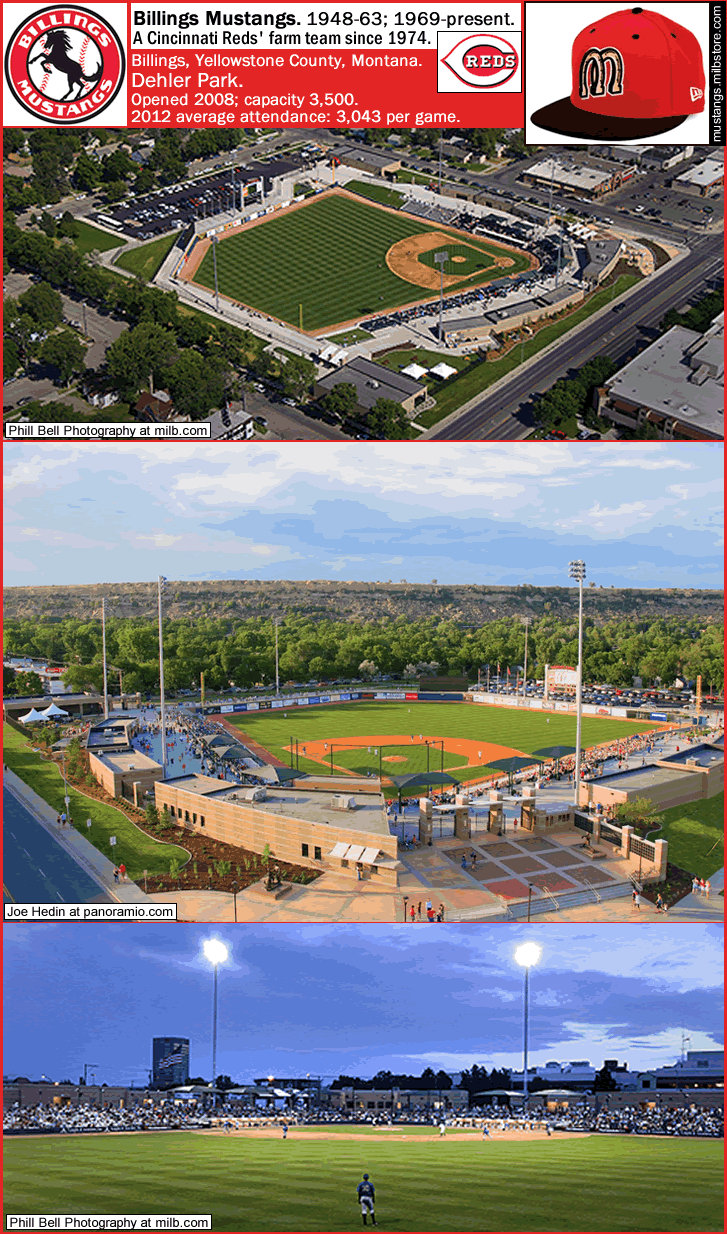
Photo credits above –
mustangs.milbstore.com.
Phil Bell Photography at milb.com.
Joe Hedin at panoramio.com via tripomatic.com/United-States/Montana/Billings/Dehler-Park.
Phil Bell Photography at milb.com.
___
Photo credits on the map page -
Billings Mustangs/ Dehler Park, Joe Hedin at panoramio.com via tripomatic.com/United-States/Montana/Billings/Dehler-Park.
Great Falls Voyagers/ Centene Stadium, the baseball travele…at panoramio.com.
Helena Brewers/ Kindrik Legion Field, digitalballparks.com.
Missoula Osprey/ Ogren Park at Allegiance Field, murphsroadtrips.blogspot.com/2011/06/missoula-osprey-vs-billings-mustangs.
…
Grand Junction Rockies/ Suplizio Field, the baseball travelle… at panoramio.com.
Idaho Falle Chukats/ Melalaueca Field, ballparksite.host56.com.
Ogden Raptors/ Lundquist Field, the baseball travelle… at panoramio.com.
Orem Owlz/ Brent Brown Ballpark, utahvalley.com.
…
Thanks to Theshibboleth at en.wikipedia.org, for the USA blank map, http://en.wikipedia.org/wiki/File:Blank_US_Map.svg.
Thanks to milb.com for attendances, http://www.milb.com/milb/stats/stats.jsp?sid=milb&t=l_att&lid=123.
Thanks to baseball-reference.com/minors, http://www.baseball-reference.com/.
